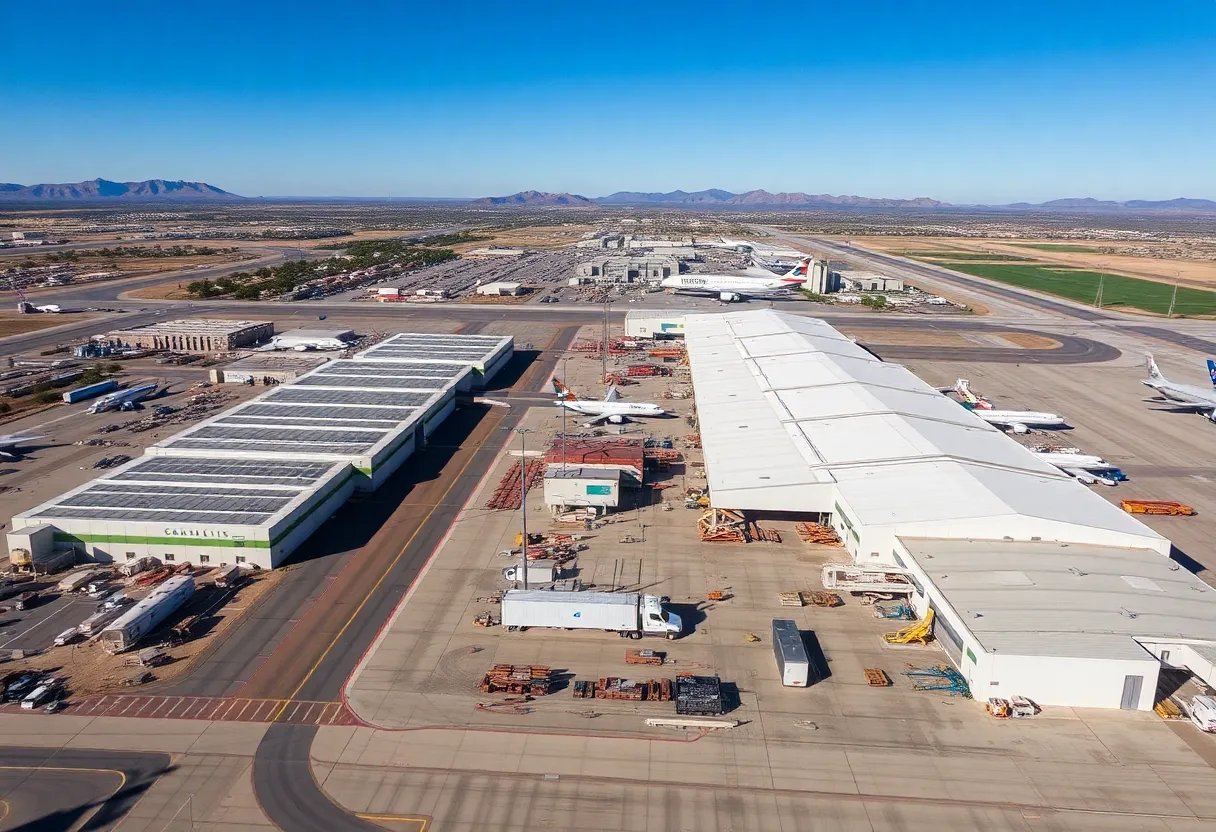Tucson, October 19, 2025
Tucson International Airport has initiated a $10 million upgrade to its cargo terminal, doubling its capacity and supporting the vital U.S.-Mexico commerce corridor valued at $50 billion. This expansion aims to enhance logistics for cross-border trade, with airlines like FedEx expecting a 30% increase in traffic. The upgrade is projected to create 120 new jobs in logistics, strengthening the local economy and positioning Tucson as a crucial hub for regional supply chains.
Tucson, Arizona, Boosts Cargo Capabilities with $10 Million Airport Upgrade
Tucson International Airport has launched a $10 million upgrade to its cargo terminal, aimed at strengthening logistics for cross-border trade. This expansion will double the terminal’s capacity, directly supporting the bustling $50 billion U.S.-Mexico commerce corridor. Airlines such as FedEx expect a 30% growth in traffic as a result, positioning the airport as a vital player in regional supply chains.
Key Details of the Expansion
The project focuses on modernizing infrastructure to handle increased volumes of goods moving between the United States and Mexico. By doubling the cargo handling space, the terminal will process more shipments efficiently, reducing delays and costs for businesses reliant on timely deliveries. This upgrade comes at a critical time, as trade volumes in the border region continue to rise due to growing e-commerce demands and manufacturing needs.
Airport officials describe the initiative as a strategic move to establish Tucson as a Southwest hub for logistics. The enhanced facilities will include advanced sorting systems, expanded storage areas, and improved access for trucks and aircraft. These changes are designed to accommodate larger cargo planes and streamline operations, making the airport more competitive against larger facilities in nearby cities.
Economic Impacts and Job Growth
The upgrade is projected to create 120 new roles in logistics, spanning positions from warehouse operators to transportation coordinators. This influx of jobs will provide stable employment opportunities for local residents, particularly in a region where logistics and trade form a backbone of the economy. Beyond direct hiring, the project is expected to stimulate broader economic activity by supporting e-commerce platforms and manufacturing firms that depend on efficient cross-border shipping.
Local businesses involved in exporting goods, such as electronics, automotive parts, and agricultural products, stand to benefit most. The increased capacity will help them scale operations without facing bottlenecks at the airport, fostering growth in sectors that contribute significantly to the area’s GDP. As trade between the U.S. and Mexico accounts for a substantial portion of regional commerce, this development could ripple outward, enhancing supply chain reliability for companies nationwide.
Timeline and Implementation
Construction on the cargo terminal upgrade began recently, with completion targeted for late 2026. The phased approach ensures minimal disruption to current operations while allowing for testing of new equipment. Initial phases will prioritize expanding the physical footprint, followed by the integration of technology for better tracking and security of shipments.
Broader Context of Regional Trade
The U.S.-Mexico commerce corridor, valued at $50 billion annually, relies heavily on efficient border infrastructure. Tucson’s location near the international boundary makes it an ideal gateway for goods flowing between the two countries. In recent years, trade has surged due to agreements like the USMCA, which encourage manufacturing and distribution activities across the border.
This airport project aligns with ongoing efforts to modernize transportation networks in the Southwest. Similar investments in ports and highways have already improved connectivity, but air cargo remains a fast-growing segment, especially for time-sensitive items. By addressing capacity constraints, Tucson International Airport aims to capture a larger share of this market, potentially attracting more carriers and freight forwarders to the region.
Challenges such as regulatory hurdles and labor shortages in logistics could influence the project’s success, but the focus on job creation addresses some of these issues head-on. Overall, the upgrade represents a forward-thinking investment in infrastructure that could solidify Tucson’s role in North American trade for years to come.
The initiative underscores the importance of adapting to global trade dynamics. As e-commerce continues to expand—driven by consumer demand for quick deliveries—airports like Tucson’s are essential for keeping pace. This development not only enhances local capabilities but also contributes to the resilience of the broader U.S.-Mexico economic partnership.
FAQ
What is the main purpose of the Tucson International Airport cargo terminal upgrade?
The upgrade enhances logistics for cross-border trade by doubling the terminal’s capacity, serving the $50 billion U.S.-Mexico commerce corridor.
How much is the investment in the cargo terminal expansion?
The project involves a $10 million upgrade to the cargo terminal.
What growth do airlines like FedEx anticipate from this upgrade?
Airlines like FedEx anticipate 30% traffic growth as a result of the expansion.
How will this position Tucson in the region?
This positions Tucson as a Southwest hub for logistics.
What economic benefits are projected from the upgrade?
Job creation of 120 roles in logistics is projected, stimulating e-commerce and manufacturing sectors.
When was this announcement published?
The announcement was published on October 19, 2025.
Key Features of the Tucson Airport Cargo Upgrade
Below is a table summarizing the key aspects of the $10 million cargo terminal expansion at Tucson International Airport.
| Feature | Details |
|---|---|
| Investment Amount | $10 million upgrade to the cargo terminal |
| Capacity Impact | Doubles the terminal’s capacity |
| Trade Corridor Served | $50 billion U.S.-Mexico commerce corridor |
| Anticipated Traffic Growth | 30% growth for airlines like FedEx |
| Strategic Positioning | Positions Tucson as a Southwest hub |
| Job Creation | 120 roles in logistics |
| Sector Stimulation | Stimulates e-commerce and manufacturing sectors |
Deeper Dive: News & Info About This Topic
HERE Resources
Tucson International Airport Reports 15% Increase in Passengers
Tucson Airport Begins $50 Million Expansion Project




